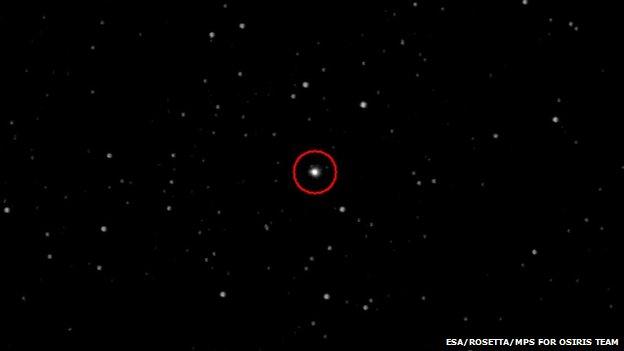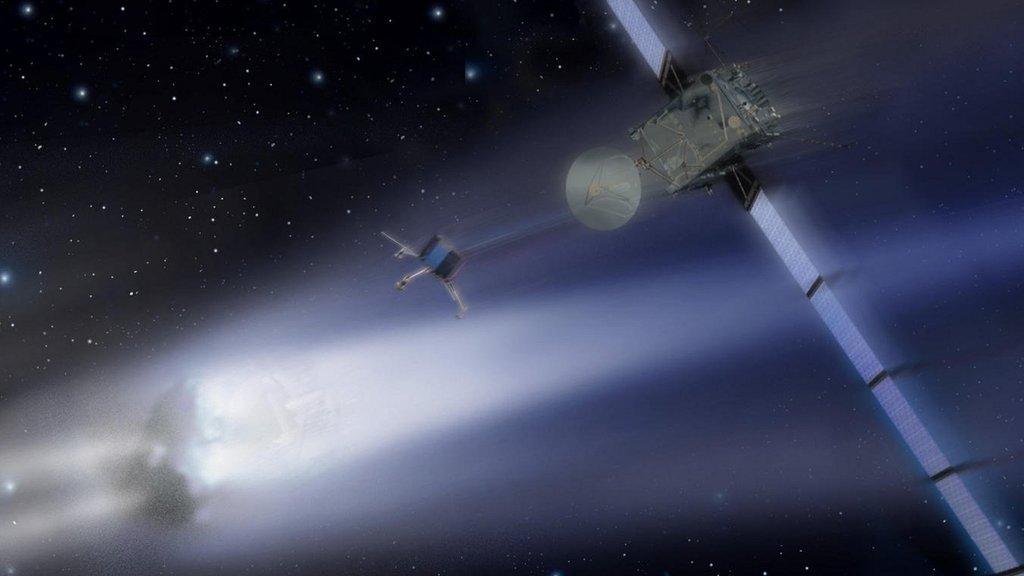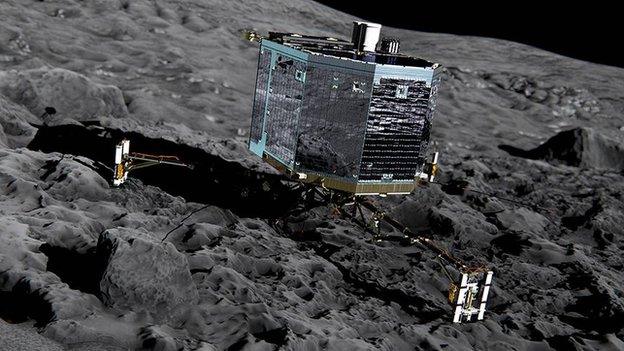Rosetta: Icy quarry coming into view
- Published
- comments

Rosetta views Comet 67P on 4 June, using the Osiris Narrow Angle Camera
Take your seats because the show is about to begin.
The European Space Agency's Rosetta probe is edging ever closer to the Comet 67P/Churyumov-Gerasimenko for what is expected to be one of the most daring space encounters in history.
Wednesday saw the satellite successfully complete the fourth of its 10 planned thruster manoeuvres.
These are designed to get the mission into orbit around the 4km-wide comet on 6 August.
Today (Thursday), the separation between Rosetta and its icy quarry is about 165,000km.
"We're now less than half the Earth-Moon distance. That's how close we are now," explained Prof Holger Sierks, who leads the Osiris camera team on Rosetta.
"I think anybody on the street will understand that - it's actually really close-by in space."
The picture at the top of this page is the first of what will be a regular release now from Prof Sierks and his team at the Max Planck Institute for Solar System Research, in Göttingen, Germany.
The comet may not be much to look at just yet - it is now barely a pixel across - but it will simply get bigger and bigger.
One of the key jobs the Osiris camera system has right now is to eyeball the comet to assist with navigation.
But, of course, it's also a very important science instrument.
Not only will Osiris map the object and its surface features, but it carries a number of filters to elicit information about chemical composition.
Imaging is being supported by big ground-based telescopes.
Interesting observations already emerging relate to the activity of the comet.
A few weeks back, it was seen to be throwing out quite a bit of material - gas and dust. Not anymore.
"The comet, after a short time of activity, is back at rest," says Prof Sierks. "So, the message I guess is expect the unexpected."
As the comet moves closer to the Sun, it will get significantly more active, and Osiris will have to take care to protect the optics on its wide and narrow-angle cameras.
It has a set of doors that will open only when images are being acquired.
"This is a must do," says Prof Sierks. "It's essential because we want to preserve the quality of our mirrors, which are directly exposed to the dust flow.
"The system is set out and qualified for many, many door cycles. We open the door and shoot, shoot, shoot - and then close the door.
"In normal circumstances, such as on our camera on [Nasa's asteroid mission] Dawn, we are qualified for 400 cycles. In the environment around an asteroid, you can open the door and leave it open.
"But with Rosetta, we are qualified for 10,000 door cycles. We could be opening and closing the door maybe 10 or 20 times a day. So we open an eye, look quickly for what we want, and then close the eye."
The next image release is likely to occur on 3 July. By then, 67P will be about six pixels across.
Osiris' early tasks will be to find a suitable location for Rosetta to put down its Philae lander.
It will start by making a global map at a resolution of about 20m. A site selection process will then narrow to a choice of two landing zones (first choice and back-up), which will be imaged at roughly 50cm resolution.
By moving in very close itself, Rosetta can get much more detailed pictures, but the error on the landing is going to be on the order of 100m so tracing every bump and dip on the comet is just not necessary.
Philae's landing is still projected for early November.
I learnt this week that the main probe may also end its days by being dropped on to the surface of 67P, in much the same way as the Near-Shoemaker spacecraft was intentionally ditched on Asteroid 433 Eros in 2001. But that is a way down the road; first, let's just get to the comet.

- Published22 May 2014

- Published28 March 2014

- Published20 January 2014

- Published18 September 2013